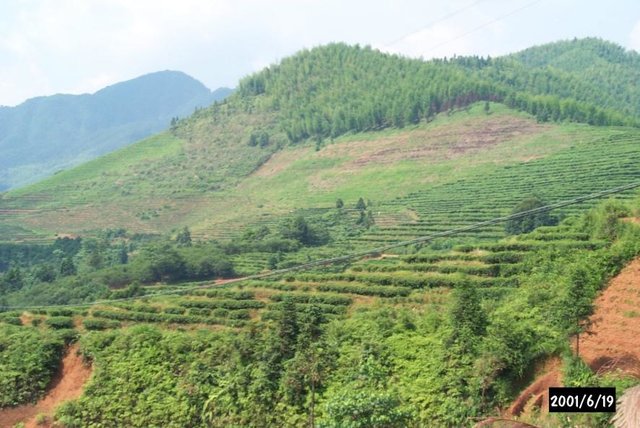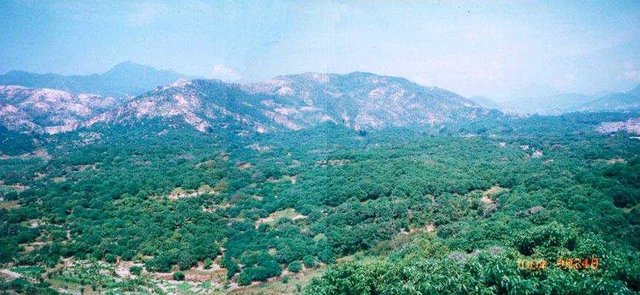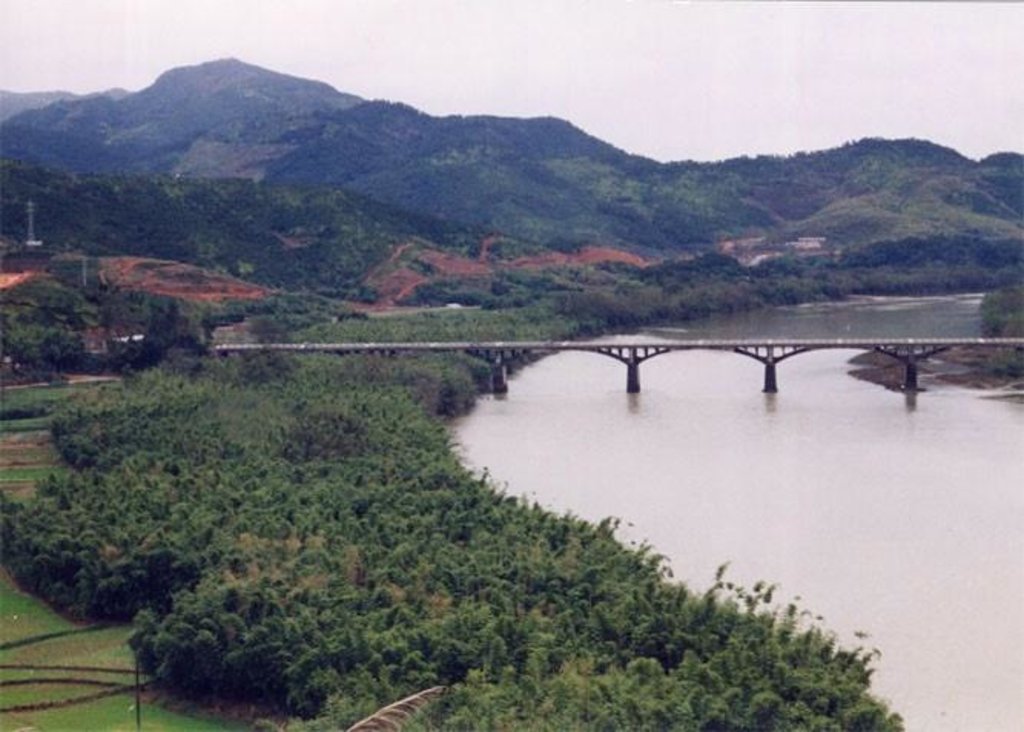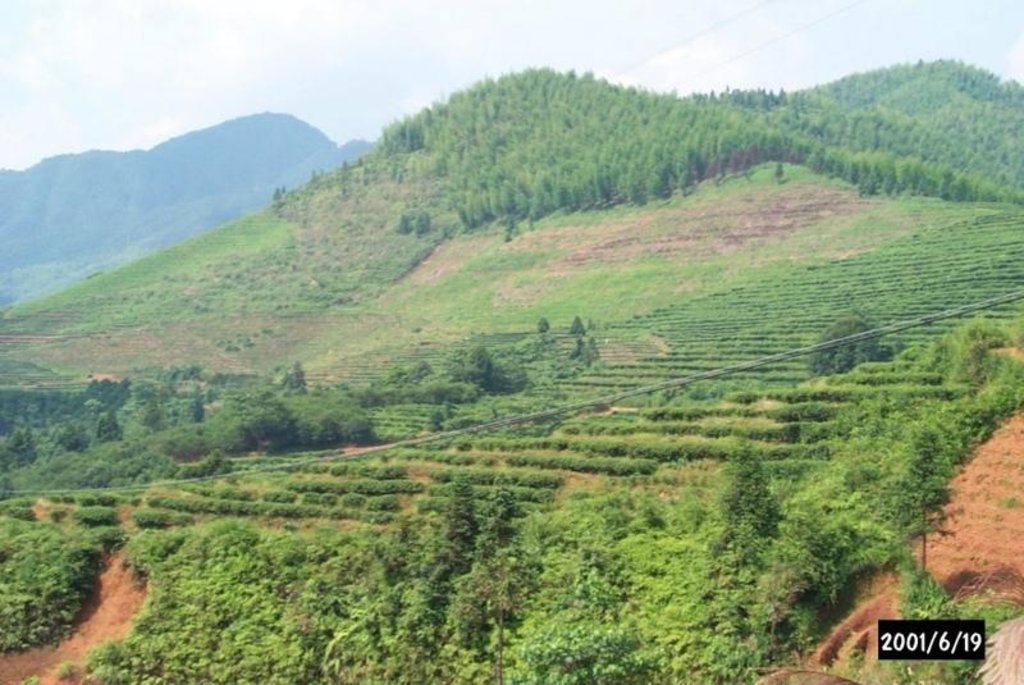Comprehensive Development & Management of a Small Watershed [China]
- Creación:
- Actualización:
- Compilador: Unknown User
- Editor: –
- Revisor: David Streiff
Intergraded development of a small watershed
technologies_971 - China
Visualizar secciones
Expandir todo Colapsar todos1. Información general
1.3 Condiciones referidas al uso de datos documentados mediante WOCAT
¿Cuándo se compilaron los datos (en el campo)?
19/06/2001
El compilador y la/s persona(s) de referencia claves aceptan las condiciones acerca del uso de los datos documentados mediante WOCAT:
Sí
1.5 Referencia al (los) Cuestionario(s) de Enfoques MST

Comprehensive Development & Management of a Small Watershed [China]
The comprehensive measures including interplanting & intercropping are applied in the small watershed to control soil and water loss and improve land production and farmers' income.
- Compilador: Unknown User

Interplanting fruit trees of Longan, Peach, Plum etc. [China]
Interplanting plum, peach and other fruit trees in longan orchard on level terraces in order to prevent soil and water loss and improve production of the fruit trees.
- Compilador: zhangsheng LIU
2. Descripción de la Tecnología MST
2.1 Breve descripción de la Tecnología
Definición de la Tecnología:
The comprehensive measures including interplanting & intercropping are applied in the small watershed to control soil and water loss and improve integrated production.
2.2 Descripción detallada de la Tecnología
Descripción:
Based on the national conditions and soil and water loss in the area, the corresponding SWC measures were adopted to pursue the targets including: 1. Closing the hilly and mountain area of 224ha for the timber forest and grass growing as well as preventing soil and water loss; 2. Adjusting the land use structure so as to strengthen the comprehensive development of the hilly land as well as crop land irrigation; 3. Changing the area of W & S loss to economic vegetation land; 4. Constructing reservoirs and roads.
2.3 Fotografías de la Tecnología
2.5 País/ región/ lugares donde la Tecnología fue aplicada y que se hallan comprendidos por esta evaluación
País:
China
Región/ Estado/ Provincia:
Fujian Province
Map
×2.6 Fecha de la implementación
Si no se conoce el año preciso, indique la fecha aproximada:
- hace menos de 10 años (recientemente)
2.7 Introducción de la Tecnología
Especifique cómo se introdujo la Tecnología:
- mediante proyectos/ intervenciones externas
Comentarios (tipo de proyecto, etc.):
Based on the long term experiences of the mass's practice in SWC, the SWC specialists innovated through guidance, design and implementation of local water & soil conservation.
3. Clasificación de la Tecnología MST
3.1 Propósito(s) principal(es) de la Tecnología MST
- proteger una cuenca hidrográfica/ áreas corriente abajo – en combinación con otras Tecnologías
3.2 Tipo(s) actuales de uso de la tierra donde se aplica la Tecnología

Tierras cultivadas
- Cosecha anual
Cosechas principales (comerciales y de subsistencia):
Rice-rice; Tea, grape etc.

Bosques
Productos y servicios:
- Madera
- Pastoreo/ ramoneo
- Conservación/ Protección de la naturaleza
Comentarios:
Major land use problems (compiler’s opinion): The layout of vegetation is not rational. The traffic is not convenient.
Major land use problems (land users’ perception): Lack of new species and SWC technique. Hopefully more funds could be supported from government.
Grazingland comments: Reclaiming fish pools area of 5.6 ha, stall breeding chicken, duck etc.
Problems / comments regarding forest use: Planting young bamboo in the sparse woodland (about 135 ha) in the western watershed and planting lotus after deforesting the woodland (36.7 ha) in the southwestern watershed as well as changing the adult tea gardens to afforest in the northeast watershed.
Forest products and services: timber, grazing / browsing, nature conservation / protection
Type of grazing system comments: Reclaiming fish pools area of 5.6 ha, stall breeding chicken, duck etc.
3.3 Información adicional sobre el uso de tierras
Provisión de agua para la tierra donde se aplica la Tecnología:
- de secano
Comentarios:
Water supply also mixed rainfed-irrigated
Número de temporadas de cultivo por año:
- 1
Especifique:
Longest growing period in days: 365Longest growing period from month to month: Jan - Dec
3.4 Grupo MST al que pertenece la Tecnología
- manejo de agua superficial (manantial, río, lagos, mar):
3.5 Difusión de la Tecnología
Especifique la difusión de la Tecnología:
- distribuida parejamente sobre un área
Si la tecnología se halla difundida homogéneamente en un área, indique el área aproximada que cubre:
- 1-10 km2
Comentarios:
Total area covered by the SLM Technology is 5.93 m2.
Xinxili small watershed is located in southern Zhenghe county. It belongs to administration of Jiefang village of Xiongshan town including three villages. The area of the watershed is about 606 ha. The weather in the region is sub-tropical monsoon climate with artificial vegetation. The soil type is red soil.
3.6 Medidas MST que componen la Tecnología

medidas agronómicas
- A1: vegetación/ cubierta del suelo

medidas estructurales
- S7: Equipo para cosechar agua / provisión de agua/ irrigación

medidas de manejo
- M1: Cambio de tipo de uso de la tierra
Comentarios:
Type of agronomic measures: mixed cropping / intercropping, mulching, minimum tillage, contour tillage
3.7 Principales tipos de degradación de la tierra encarados con la Tecnología

erosión de suelos por agua
- Wt: pérdida de capa arable/ erosión de la superficie
- Wg: erosión en cárcavas

erosión de suelos por viento
- Et: pérdida de capa arable

deterioro químico del suelo
- Cn: reducción de la fertilidad y contenido reducido de la materia orgánica del suelo (no ocasionados por la erosión)

degradación del agua
- Ha: aridificación
Comentarios:
Main type of degradation addressed: Wt: loss of topsoil / surface erosion
Secondary types of degradation addressed: Wg: gully erosion / gullying, Et: loss of topsoil, Cn: fertility decline and reduced organic matter content, Ha: aridification
Main causes of degradation: deforestation / removal of natural vegetation (incl. forest fires) (population increasing and lack of fuel), poverty / wealth (Lack of captial: Low living standard of the local people and lack of funds.)
Secondary causes of degradation: over-exploitation of vegetation for domestic use (neglecting ecological benefit, overfelling forest), other natural causes (avalanches, volcanic eruptions, mud flows, highly susceptible natural resources, extreme topography, etc.) specify (Sandy and loose red soil.)
3.8 Prevención, reducción o restauración de la degradación de la tierra
Especifique la meta de la Tecnología con relación a la degradación de la tierra:
- reducir la degradación de la tierra
4. Especificaciones técnicas, actividades de implementación, insumos y costos
4.2 Especificaciones técnicas/ explicaciones del dibujo técnico
Technical knowledge required for field staff / advisors: moderate
Technical knowledge required for land users: moderate
Main technical functions: improvement of ground cover, Improvement of soil structure
Secondary technical functions: control of dispersed runoff: impede / retard, control of concentrated runoff: retain / trap
Mixed cropping / intercropping
Remarks: Intercropping/mixed cropping
Mulching
Material/ species: Straw
Quantity/ density: all crop a
Remarks: strips
Trees/ shrubs species: fir, bamboo, horsetail pine,
Fruit trees / shrubs species: pear, loquat, peach, greengage
Slope (which determines the spacing indicated above): 25.00%
If the original slope has changed as a result of the Technology, the slope today is (see figure below): 20.00%
Gradient along the rows / strips: 20.00%
Construction material (earth): With some stone
Slope (which determines the spacing indicated above): 35.00%
If the original slope has changed as a result of the Technology, the slope today is: 25.00%
Lateral gradient along the structure: 60.00%
For water harvesting: the ratio between the area where the harvested water is applied and the total area from which water is collected is: 1:10.00
4.3 Información general sobre el cálculo de insumos y costos
Especifique la moneda usada para calcular costos:
- dólares americanos
Indique el costo promedio del salario de trabajo contratado por día:
1.44
4.4 Actividades de establecimiento
| Actividad | Tipo de medida | Momento | |
|---|---|---|---|
| 1. | closing mountain to afforest | Vegetativas | 1990 |
| 2. | planting bamboo | Vegetativas | 1990 |
| 3. | bamboo forest cultivated | Vegetativas | 1990 |
| 4. | changing farmland to forest | Vegetativas | 1990 |
| 5. | planting fruit trees | Vegetativas | 1990 |
| 6. | Building sluice dams | Estructurales | 1990 |
| 7. | road constructing | Estructurales | 1990 |
4.5 Costos e insumos necesarios para el establecimiento
Comentarios:
Duration of establishment phase: 72 month(s)
4.6 Actividades de establecimiento/ recurrentes
| Actividad | Tipo de medida | Momento/ frequencia | |
|---|---|---|---|
| 1. | fertilizing | Vegetativas | 1990-1999 /3 |
| 2. | cleaning out ruderal | Vegetativas | 1990-1999 /2 |
| 3. | Preventing and curing illness and insect pests | Vegetativas | 1990-1999 /3 |
| 4. | Broadening road | Estructurales | 1995/timely |
| 5. | highway maintenance | Estructurales | 1995/timely |
4.7 Costos e insumos necesarios para actividades de mantenimiento/ recurrentes (por año)
Comentarios:
Size of the variable structural measures and areas of grass planting.
4.8 Factores más determinantes que afectan los costos:
Describa los factores más determinantes que afectan los costos:
Because mechanic machines are not available, more labor forces are needed costing much. In addition, the expense for seeding, fertilizer, flagstone used in building dams take most of the total fees.
5. Entorno natural y humano
5.1 Clima
Lluvia anual
- < 250 mm
- 251-500 mm
- 501-750 mm
- 751-1,000 mm
- 1,001-1,500 mm
- 1,501-2,000 mm
- 2,001-3,000 mm
- 3,001-4,000 mm
- > 4,000 mm
Especifique el promedio anual de lluvia (si lo conoce), en mm:
1609,00
Zona agroclimática
- húmeda
5.2 Topografía
Pendientes en promedio:
- plana (0-2 %)
- ligera (3-5%)
- moderada (6-10%)
- ondulada (11-15%)
- accidentada (16-30%)
- empinada (31-60%)
- muy empinada (>60%)
Formaciones telúricas:
- meseta/ planicies
- cordilleras
- laderas montañosas
- laderas de cerro
- pies de monte
- fondo del valle
Zona altitudinal:
- 0-100 m s.n.m.
- 101-500 m s.n.m.
- 501-1,000 m s.n.m
- 1,001-1,500 m s.n.m
- 1,501-2,000 m s.n.m
- 2,001-2,500 m s.n.m
- 2,501-3,000 m s.n.m
- 3,001-4,000 m s.n.m
- > 4,000 m s.n.m
5.3 Suelos
Profundidad promedio del suelo:
- muy superficial (0-20 cm)
- superficial (21-50 cm)
- moderadamente profunda (51-80 cm)
- profunda (81-120 cm)
- muy profunda (>120 cm)
Materia orgánica de capa arable:
- elevada (>3%)
Si se halla disponible, adjunte una descripción completa de los suelos o especifique la información disponible, por ej., tipo de suelo, pH/ acidez de suelo, capacidad de intercambio catiónico, nitrógeno, salinidad, etc. :
soil texture: granite and fiber rock
Soil fertility: medium
Soil drainage / infiltration: good
Soil water storage capacity: high
5.6 Las características de los usuarios de la tierra que aplican la Tecnología
Ingresos no agrarios:
- 10-50% de todo el ingreso
Nivel relativo de riqueza:
- pobre
- promedio
Nivel de mecanización:
- trabajo manual
- tracción animal
Indique otras características relevantes de los usuarios de las tierras:
Population density: 50-100 persons/km2
Annual population growth: 0.5% - 1%
and own 2% of the land.
and own 2% of the land.
and own 72% of the land.
and own 10% of the land.
and own 8% of the land.
Off-farm income specification: The benefit of SWC implementation is about 1.03 million US dollars. Among them, 257,289 US Dollars from the agricultural production, 145,301 USD from the forest industry and 286,746 USD from others.
5.8 Tenencia de tierra, uso de tierra y derechos de uso de agua
Tenencia de tierra:
- estado
Derechos de uso de tierra:
- individual
6. Impactos y comentarios para concluir
6.1 Impactos in situ demostrados por la Tecnología
Impactos ecológicos
Ciclo de agua/ escurrimiento de sedimento
escurrimiento superficial
Cantidad antes de MST:
40
Cantidad luego de MST:
30
Suelo
pérdida de suelo
Cantidad antes de MST:
25
Cantidad luego de MST:
5
6.4 Análisis costo-beneficio
¿Cómo se comparan los beneficios con los costos de establecimiento (desde la perspectiva de los usuarios de tierra)?
Ingresos a corto plazo:
ligeramente negativo
Ingresos a largo plazo:
muy positivo
¿Cómo se comparan los beneficios con los costos de mantenimiento/ recurrentes (desde la perspectiva de los usuarios de tierra)?
Ingresos a corto plazo:
muy positivo
Ingresos a largo plazo:
muy positivo
6.5 Adopción de la Tecnología
- más de 50%
Si tiene la información disponible, cuantifique (número de hogares y/o área cubierta):
510 households
De todos quienes adoptaron la Tecnología, ¿cuántos lo hicieron espontáneamente, es decir, sin recibir incentivos/ pagos materiales?
- 10-50%
Comentarios:
80% of land user families have adopted the Technology with external material support
410 land user families have adopted the Technology with external material support
Comments on acceptance with external material support: estimates
20% of land user families have adopted the Technology without any external material support
100 land user families have adopted the Technology without any external material support
Comments on spontaneous adoption: estimates
There is a moderate trend towards spontaneous adoption of the Technology
Comments on adoption trend: Even without fund support, rich land users could gain added income from the implementation of SWC technique.
Vínculos y módulos
Expandir todo Colapsar todosVínculos

Comprehensive Development & Management of a Small Watershed [China]
The comprehensive measures including interplanting & intercropping are applied in the small watershed to control soil and water loss and improve land production and farmers' income.
- Compilador: Unknown User

Interplanting fruit trees of Longan, Peach, Plum etc. [China]
Interplanting plum, peach and other fruit trees in longan orchard on level terraces in order to prevent soil and water loss and improve production of the fruit trees.
- Compilador: zhangsheng LIU
Módulos
No se hallaron módulos





